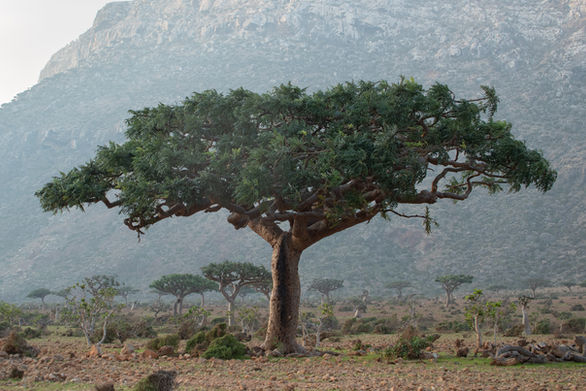
One of Socotra’s most characteristic and awe-inspiring features is the archipelago’s unique floral diversity. Throughout the common era and still today, this invaluable biological endowment has brought travelers to the archipelago from far and wide in search of valuable resins from endemic trees, healing aloes, and a myriad of other plant products. During this same time, the distinctive diversity of flora has acted as the base for the formation of a rich local ethnobotanic tradition that is still very much alive today. Yet today, the ecological and evolutionary mechanisms that make the archipelago’s flora so special also make it, and the traditions that surround it, particularly vulnerable to degradation and extinction.
The Socotra archipelago is part of the Eritreo-Arabia subregion, which also includes southern Arabia, Somalia, Ethiopia and parts of Kenya and Tanzania (Takhtajan, 1986). Within this subregion, the archipelago is particularly prominent because of its high levels of endemism. Socotra is home to 15 endemic genera and 307 endemic plant species (Miller & Morris, 2004). Given the total 825 plant species so far documented on the archipelago, this makes for 37% of total plant species being endemic. Only few other similarly sized archipelagoes on earth boast higher levels of floral endemism (Table 1).

Two explanations exist for how Socotra’s unique flora got to the archipelago: the first is that certain species migrated from the relatively nearby mainland Arabian peninsula and Horn of Africa, and even further off landmasses most probably utilizing monsoon winds and flying animals as vehicles. The other is that certain Socotri plant species are ancient relicts from when the island was part of the supercontinent Gondwanaland. The hospitable climate and stable geology of the island compared to that of surrounding continents allowed for these species to remain unchanged for millions of years. As noted by Miller and Morris, “The theories are not mutually exclusive: different taxa have different histories and both theories are supported by the distributions of related taxa from Soqotra and a wide range of other geographical areas.”

Table 1
This rich diversity of endemic flora also acts as the foundation for an important component of Socotra’s cultural heritage: ethnobotany. For thousands of years, and very much still today, Socotris have used their archipelago’s unique plants in a multitude of different ways ranging from ceremonial practices to art, medicine and currency. Throughout the archipelago’s history and still today, people from around the world visit Socotra searching for herbal remedies that cannot be found anywhere else and that purportedly worked to solve a myriad of health issues. Some of these include: using Dragon blood tree (Dracaena cinnabari) resin to stop post partum hemorrhaging and using aloe flesh and euphorbia latex to disinfect wounds, and many others.
Today, Socotra’s flora and the vast ethnobotanical tradition that formed around it are being threatened by societal and anthropomorphic environmental changes in Socotra and around the world. In addition, the study and research of Socotra’s floral biodiversity is hindered by geographical, and even more so, by political boundaries. In 2001, a group of dedicated scientists, policy makers and enthusiasts from Socotra and the world named Friends of Soqotra was formed to better study and protect Socotra’s flora and related traditions. The dedicated work of such organizations alongside passionate Socotris provides hope for the future of Socotri flora in the wld and the continuation of the various traditions surrounding it.
Literature cited:
1. Takhtajan, A. (1986) Floristic Regions of the World. University of California Press, Berkeley.
2. Miller, A.G. and Morris, M. (2004). Ethnoflora of the Soqotra Archipelago (pp. 9). Royal Botanic Garden, Edinburgh.
Iconic Socotri flora
less Iconic–equally important Socotri flora
All images from: Miller, A.G. and Morris, M. (2004). Ethnoflora of the Soqotra Archipelago (pp. 9). Royal Botanic Garden, Edinburgh.
















